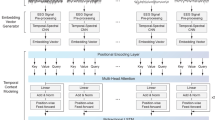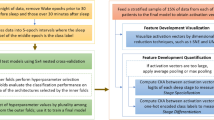Abstract
Medical data are often multi-modal, which are collected from different sources with different formats, such as text, images, and audio. They have some intrinsic connections in meaning and semantics while manifesting disparate appearances. Polysomnography (PSG) datasets are multi-modal data that include hypnogram, electrocardiogram (ECG), and electroencephalogram (EEG). It is hard to measure the associations between different modalities. Previous studies have used PSG datasets to study the relationship between sleep disorders and quality and sleep architecture. We leveraged a new method of deep learning manifold alignment to explore the relationship between sleep architecture and EEG features. Our analysis results agreed with the results of previous studies that used PSG datasets to diagnose different sleep disorders and monitor sleep quality in different populations. The method could effectively find the associations between sleep architecture and EEG datasets, which are important for understanding the changes in sleep stages and brain activity. On the other hand, the Spearman correlation method, which is a common statistical technique, could not find the correlations between these datasets.
Access this chapter
Tax calculation will be finalised at checkout
Purchases are for personal use only
Similar content being viewed by others
References
Picard-Deland, C., Carr, M., Paquette, T., Nielsen, T.: Sleep spindles are altered in early- but not late-onset nightmare recallers. Sleep Med. 52, 34–42 (2018). https://doi.org/10.1016/j.sleep.2018.07.015
Picard-Deland, C., Carr, M., Paquette, T., Saint-Onge, K., Nielsen, T.: Sleep spindle and psychopathology characteristics of frequent nightmare recallers. Sleep Med. 50, 113–131 (2018). https://doi.org/10.1016/j.sleep.2017.10.003
Purcell, S., Manoach, D., Demanuele, C., et al.: Characterizing sleep spindles in 11,630 individuals from the national sleep research resource. Nat. Commun. 8, 15930 (2017). https://doi.org/10.1038/ncomms15930
Nguyen, N.D., Huang, J., Wang, D.: A deep manifold-regularized learning model for improving phenotype prediction from multi-modal data. Nat. Comput. Sci. 2(1), 38–46 (2022)
Spearman, C.: The proof and measurement of association between two things. Am. J. Psychol. 15(1), 72–101 (1904). https://doi.org/10.2307/1412159
Simon, K.C., Nadel, L., Payne, J.D.: The functions of sleep: a cognitive neuroscience perspective. Proc. Natl. Acad. Sci. 119(44), e2201795119 (2022)
Leary, E.B., et al.: Association of rapid eye movement sleep with mortality in middle-aged and older adults. JAMA Neurol. 77, 1241–1251 (2020)
Winer, J.R., et al.: Sleep disturbance forecasts β-amyloid accumulation across subsequent years. Curr. Biol. 30, 4291–4298 (2020)
Xiong, X., Hu, T., Yin, Z., Zhang, Y., Chen, F., Lei, P.: Research advances in the study of sleep disorders, circadian rhythm disturbances and Alzheimer’s disease. Front. Aging Neurosci. 14, 930 (2022)
Zhang, Y., et al.: Sleep in Alzheimer’s disease: a systematic review and meta-analysis of poly-somnographic findings. Transl. Psychiatry 12(1), 1–12 (2022)
Djonlagic, I., et al.: Associations between quantitative sleep EEG and subsequent cognitive decline in older women. J. Sleep Res. 28(3), e12666 (2019)
Geng, D., Wang, C., Fu, Z., Zhang, Y., Yang, K., An, H.: Sleep EEG-based approach to de-tect mild cognitive impairment. Front. Aging Neurosci. 14, 865558 (2022)
Sun, H., et al.: Brain age from the electroen-cephalogram of sleep. Neurobiol. Aging 1(74), 112–120 (2019)
Ye, E., et al.: Association of sleep electroencephalography-based brain age index with dementia. JAMA Netw. Open 3(9), e2017357 (2020)
Zhang, G.Q., et al.: The National Sleep Research Resource: towards a sleep data commons. J. Am. Med. Inform. Assoc. 25(10), 1351–1358 (2018). https://doi.org/10.1093/jamia/ocy064
Quan, S.F., et al.: The Sleep Heart Health Study: design, rationale, and methods. Sleep 20(12), 1077–1085 (1997). PMID: 9493915
NSRR Homepage: https://sleepdata.org/
Ham, J.H., Lee, D.D., Saul, L.K.: Learning high dimensional correspondences from low dimensional manifolds. In: Proceedings of the Twentieth International Conference on Machine Learning (ICML-2003) (2003)
Acknowledgements
The Sleep Heart Health Study (SHHS) was supported by National Heart, Lung, and Blood Institute cooperative agreements U01HL53916 (University of California, Davis), U01HL53931 (New York University), U01HL53934 (University of Minnesota), U01HL53937 and U01HL64360 (Johns Hopkins University), U01HL53938 (University of Arizona), U01HL53940 (University of Washington), U01HL53941 (Boston University), and U01HL63463 (Case Western Reserve University). The National Sleep Research Resource was supported by the National Heart, Lung, and Blood Institute (R24 HL114473, 75N92019R002).
The study is partially supported by NIH R21 AG070909-01, P30 AG072946-01, and R01 HD101508-01.
Author information
Authors and Affiliations
Corresponding author
Editor information
Editors and Affiliations
Rights and permissions
Copyright information
© 2023 The Author(s), under exclusive license to Springer Nature Switzerland AG
About this paper
Cite this paper
Wirian, Y.B., Jiang, Y., Cerel-Suhl, S., Suhl, J., Cheng, Q. (2023). Exploring the Link Between Brain Waves and Sleep Patterns with Deep Learning Manifold Alignment. In: Younas, M., Awan, I., Benbernou, S., Petcu, D. (eds) The 4th Joint International Conference on Deep Learning, Big Data and Blockchain (DBB 2023). Deep-BDB 2023. Lecture Notes in Networks and Systems, vol 768. Springer, Cham. https://doi.org/10.1007/978-3-031-42317-8_7
Download citation
DOI: https://doi.org/10.1007/978-3-031-42317-8_7
Published:
Publisher Name: Springer, Cham
Print ISBN: 978-3-031-42316-1
Online ISBN: 978-3-031-42317-8
eBook Packages: Intelligent Technologies and RoboticsIntelligent Technologies and Robotics (R0)




